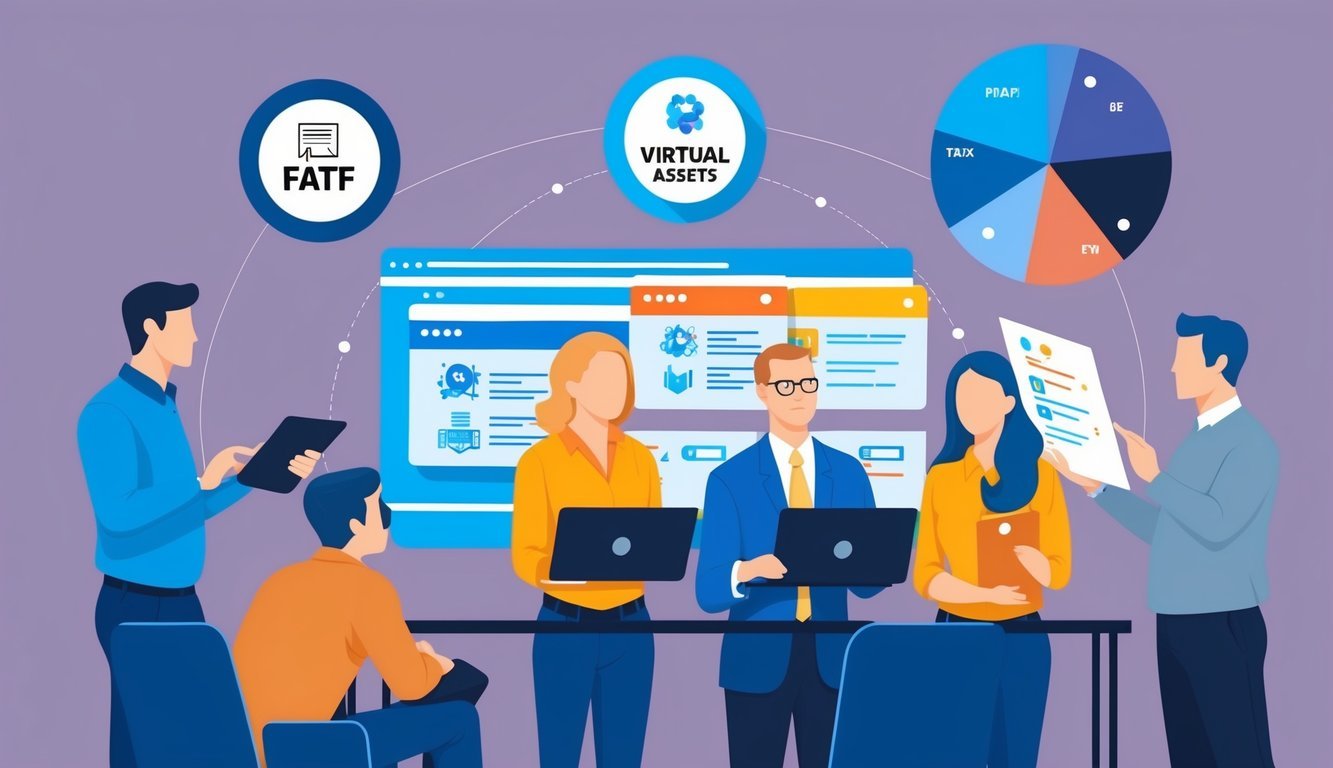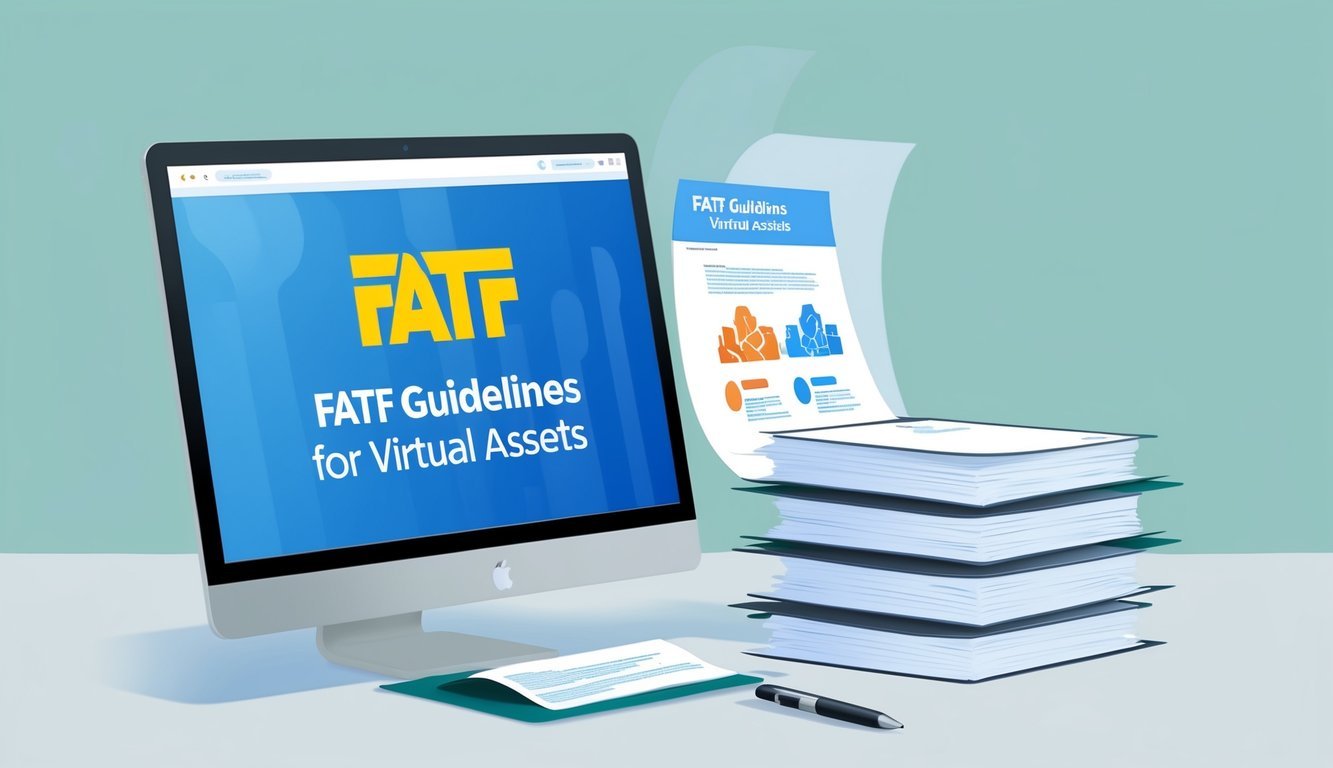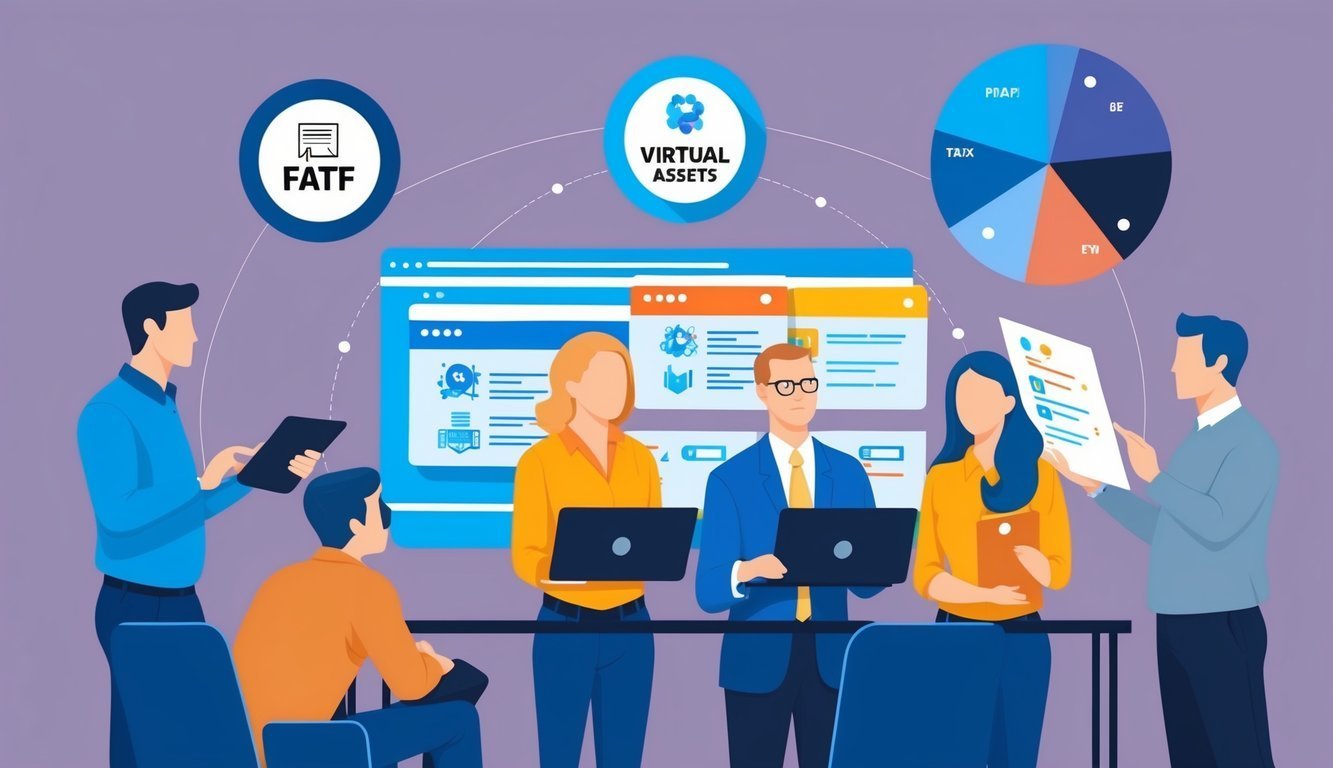Virtual assets like cryptocurrencies are changing how we think about money. The Financial Action Task Force (FATF) wants to make sure these new technologies don’t become tools for criminals. In 2021, they updated their guidance on how to handle virtual assets safely.

The FATF’s updated rules help countries and businesses figure out how to deal with virtual assets without letting bad guys take advantage of them.
These guidelines cover everything from defining what counts as a virtual asset to explaining how companies that work with them should follow anti-money laundering rules.As virtual assets become more popular, it’s important to understand these rules. They affect how you can buy, sell, and use cryptocurrencies. The guidance also talks about new trends like decentralized finance, showing that regulators are trying to keep up with the fast-changing world of digital money.
Key Takeaways
- FATF guidelines aim to prevent criminal use of virtual assets while supporting innovation
- Companies dealing with virtual assets must follow anti-money laundering rules
- The updated guidance addresses new developments like decentralized finance
Foundations and Definitions
The world of virtual assets can be tricky to navigate. Let’s break down the key concepts and players you need to know about.
Understanding Virtual Assets
Virtual assets (VAs) are digital representations of value that you can trade or transfer electronically. They’re not your typical money or financial instruments. Think Bitcoin, Ethereum, and other cryptocurrencies.
VAs work on blockchain technology. This is like a digital ledger that keeps track of all transactions. It’s decentralized, meaning no single authority controls it.
You can use VAs to:
- Buy goods and services
- Invest or speculate
- Store value (like digital gold)
But be careful! Their value can be pretty volatile. One day you’re rich, the next you’re not.
Role of the FATF
The Financial Action Task Force (FATF) is like the global watchdog for money matters. They keep an eye on financial crimes and set standards to fight them.
When it comes to virtual assets, FATF has been busy. They’ve created guidelines to help countries and businesses deal with VAs safely.
FATF’s main goals for VAs are:
- Prevent money laundering
- Stop terrorist financing
- Protect the financial system
They update their guidance regularly to keep up with this fast-moving sector. In 2021, they released new rules to make the VA world safer for everyone.
Virtual Asset Service Providers Explained
Virtual Asset Service Providers (VASPs) are the businesses that help you interact with VAs. They’re like the middlemen of the crypto world.
Types of VASPs include:
- Cryptocurrency exchanges
- Wallet providers
- Companies that issue virtual assets
If you’re using a platform to buy, sell, or store cryptocurrencies, you’re probably dealing with a VASP.
VASPs have to follow strict rules set by FATF and local regulators. They need to:
- Verify your identity
- Monitor transactions
- Report suspicious activity
This helps keep the virtual asset space safe and clean for everyone to use.
Regulatory Considerations
Virtual asset service providers face key rules from regulators. You need to know about licensing, transaction reporting, and ongoing oversight to stay compliant.
Licensing and Registration Requirements
To operate legally, you’ll need proper licenses and registration. Most countries now require virtual asset businesses to register with financial authorities. You’ll likely need to submit details on your operations, security measures, and key personnel. It’s essential to familiarize yourself with the specific regulations in your jurisdiction, as compliance can vary significantly. A comprehensive crypto licensing requirements overview can help you navigate these regulations and ensure you meet all necessary standards. Additionally, working with legal experts in the field can streamline the process and reduce the risk of non-compliance penalties.
The process can be complex. Be ready to show how you’ll prevent money laundering and terror financing. You may need to prove your cybersecurity practices too.
Some jurisdictions have stricter rules than others. Research requirements carefully in each place you plan to do business. Getting approved can take months, so start early.
Complying with the Travel Rule
The “Travel Rule” is a big deal for virtual asset transfers. It says you must share certain info about senders and recipients for transactions over $1,000.
This includes:
- Names
- Account numbers
- Addresses
- National ID numbers
You’ll need systems to securely gather and transmit this data. It can be tricky with blockchain’s privacy focus. New tech solutions are emerging to help.
Failing to comply can mean big fines. Make sure your staff understands the rules. Keep good records to show regulators you’re following the rule.
Supervision and Monitoring
Expect ongoing oversight once you’re up and running. Regulators will check if you’re following anti-money laundering (AML) and counter-terrorist financing (CFT) rules.
You might face:
- Regular audits
- Surprise inspections
- Requests for transaction data
Keep detailed records of all your compliance efforts. Be ready to show how you spot and report suspicious activity.
Staying on top of changing rules is key. Laws around virtual assets evolve fast. Set up a system to track new regulations in your markets. Consider joining industry groups to stay informed.
Risk Management Strategies
Virtual asset businesses need smart ways to handle risks. You’ll want to focus on spotting shady deals, stopping bad guys from moving money, and blocking cash for terrorists. Here are some key tips to keep your business safe.
Adopting a Risk-Based Approach
You should tailor your risk management to your specific business. Take a good look at your customers, products, and where you operate. Some areas need more attention than others.
Make a list of your biggest risks. Is it sketchy new users? Tricky cross-border transfers? Pin these down.
Set up checks that match the risk level. High-risk stuff needs extra eyes on it. Low-risk? You can ease up a bit.
Keep tabs on what’s working and what’s not. The crypto world moves fast, so your risk plans need to keep up.
Mitigating Money Laundering Threats
Bad actors love using crypto to hide dirty money. You need to be on your toes to catch them.
Put solid “know your customer” (KYC) rules in place. Get real IDs and check them out. Don’t let fake accounts slip through.
Watch for weird patterns. Lots of small transfers? Sudden big moves? Those could be red flags.
Train your team to spot fishy behavior. The more eyes you have looking, the safer you’ll be.
Use tech to your advantage. Smart software can flag odd transactions way faster than humans.
Countering Terrorist Financing Risks
Terrorists might try to use your platform to move cash. You’ve got to shut that down fast.
Keep a list of known bad guys and groups. Check new users against it. Block anyone who pops up.
Look out for transfers to high-risk areas. Some places are hotspots for terrorism funding.
Set limits on how much can move at once. Big, fast transfers are harder to catch.
Work with other businesses and law enforcement. Sharing info can help everyone stay safer.
The Evolving Landscape

The virtual asset world is changing fast. New tech and ways of trading are popping up all the time. You need to stay on top of these changes to keep your money safe.
The Impact of DeFi and NFTs
Decentralized finance (DeFi) is shaking things up. It’s like a new financial system without banks. You can lend, borrow, and trade without middlemen.
NFTs are digital items you can own. They’re big in art and gaming. But they can be risky too. Some people use them to hide money.
The FATF is trying to figure out how to handle these new tools. They want to stop bad guys from using them. But they don’t want to slow down innovation.
Adjusting to the Growth of Peer-to-Peer Exchanges
Peer-to-peer (P2P) trading is getting more popular. It’s when you trade directly with other people, not through a company.
This can be tricky for regulators. It’s harder to track who’s doing what. The FATF is looking at ways to keep an eye on P2P trades.
They might ask countries to:
- Watch P2P platforms more closely
- Make rules for P2P trades
- Help people understand the risks
Facing the Challenges of Stablecoins and Digital Currencies
Stablecoins are a big deal now. They’re crypto that tries to keep a steady value. Some people think they could replace regular money one day.
Central banks are making their own digital money too. These could change how you use cash.
The FATF is working on rules for these new coins. They want to make sure they’re safe to use. But they also don’t want to stop new ideas from happening.
They’re asking people what they think about these issues. It’s called a public consultation. This helps them make better rules that work for everyone.
Frequently Asked Questions

The FATF has made important updates to its guidelines for virtual assets. These changes affect how businesses and regulators handle digital currencies and related services.
What changes did the FATF make in Recommendation 15 regarding virtual assets?
The FATF expanded its standards to cover virtual assets and related service providers. This means countries now need to regulate virtual asset activities for money laundering and terrorist financing risks.
The updated guidance clarifies how existing rules apply to new technologies. It also provides more details on how to implement these standards.
How does the Travel Rule apply to virtual assets and VASPs?
The Travel Rule requires VASPs to share customer info when transferring funds. This now applies to virtual asset transfers too.
You need to include sender and recipient details for transactions over a certain amount. The goal is to make virtual asset transfers more traceable.
Can you give some everyday examples of virtual assets?
Virtual assets include cryptocurrencies like Bitcoin and Ethereum. They can also be tokens used in online games or loyalty programs.
Some virtual assets represent ownership of real-world items. Others are purely digital with no physical counterpart.
What are some red flag indicators of illicit activities with virtual assets?
Watch out for unusually large transactions or frequent small transfers. Be wary of accounts with lots of incoming funds but few outgoing transactions.
Transactions to high-risk countries or anonymous services can be suspect. Sudden changes in transaction patterns might also indicate illegal activity.
Are there specific regulations in place for virtual assets?
Many countries have created new laws for virtual assets. These often focus on preventing money laundering and terrorist financing.
You’ll find rules about registering as a VASP, keeping customer records, and reporting suspicious transactions. Some places also have tax laws for virtual asset gains.
How is a VASP defined under FATF guidelines?
According to FATF guidelines, a VASP is any business that handles virtual assets for customers. This includes exchanges, transfer services, and wallet providers.
If you buy, sell, or store virtual assets for others, you might be a VASP. The definition also covers businesses involved in initial coin offerings.





